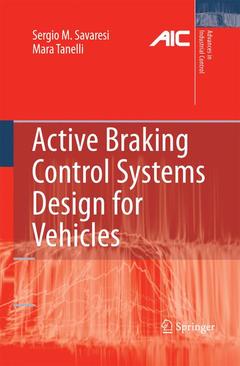Description
Active Braking Control Systems Design for Vehicles, 2010
Advances in Industrial Control Series
Authors: Savaresi Sergio M., Tanelli Mara
Language: English
Subject for Active Braking Control Systems Design for Vehicles:
105.49 €
In Print (Delivery period: 15 days).
Add to cart
Active Braking Control Systems Design for Vehicles
Publication date: 11-2014
254 p. · 15.5x23.5 cm · Paperback
Publication date: 11-2014
254 p. · 15.5x23.5 cm · Paperback
105.49 €
In Print (Delivery period: 15 days).
Add to cart
Active Braking Control Systems Design for Vehicles
Publication date: 09-2010
254 p. · 15.5x23.5 cm · Hardback
Publication date: 09-2010
254 p. · 15.5x23.5 cm · Hardback
Description
/li>Contents
/li>Comment
/li>
Active Braking Control Design for Road Vehicles focuses on two main brake system technologies: hydraulically-activated brakes with on?off dynamics and electromechanical brakes, tailored to brake-by-wire control. The physical differences of such actuators enjoin the use of different control schemes so as to be able fully to exploit their characteristics. The authors show how these different control approaches are complementary, each having specific peculiarities in terms of either performance or of the structural properties of the closed-loop system. They also consider other problems related to the design of braking control systems, namely: ? longitudinal vehicle speed estimation and its relationship with braking control system design; ? tire?road friction estimation; ? direct estimation of tire?road contact forces via in-tire sensors, providing a treatment of active vehicle braking control from a wider perspective linked to both advanced academic research and industrial reality.
Braking Control Systems Design: Introduction and Modelling.- to Active Braking Control Systems.- Control-oriented Models of Braking Dynamics.- Braking Control Systems Design: Basic Solutions.- Braking Control Systems Design: Actuators with Continuous Dynamics.- Braking Control Systems Design: Actuators with Discrete Dynamics.- Longitudinal Wheel Slip Estimation.- Braking Control Systems Design: Advanced Solutions.- Mixed Slip and Deceleration Control.- Nonlinear Wheel Slip Control Design.- Identification of Tyre–road Friction Conditions.
Extensive industrial collaboration during the research presented ensures that results are relevant in the real world as well as in pure academic research Discusses the differences in control systems necessary for two widely-used forms of braking system Offers the reader a structured and detailed treatment, not matched elsewhere, of the uses of control in various aspects of modern automotive braking systems, contributing to vehicle safety and ride quality Includes supplementary material: sn.pub/extras
© 2024 LAVOISIER S.A.S.




